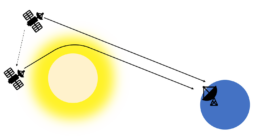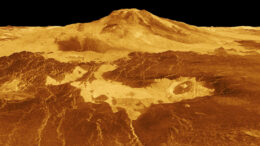The next decade will bring several new spacecraft missions to our neighboring planet, Venus. In a recent research article, scientists explored how these missions might use radio signals to detect tiny amounts of sulfur-containing molecules, illuminating the dynamics of Venus’s thick atmosphere and potentially helping us track down active volcanoes.
Venus-Bound Spacecraft

An (extremely exaggerated!) example of how the spacecraft’s radio signal is affected by its passage through Venus’s atmosphere. The atmosphere weakens the radio signal, and the refraction, or bending, of the signal imposes an apparent frequency shift that is detected by the ground station on Earth. [Kerry Hensley]
Cleverly, scientists realized decades ago that by purposefully transmitting radio signals through a planet’s atmosphere, we can study the density, temperature, and makeup of that atmosphere. This technique, which is called a radio occultation, gives us an additional way to study Venus’s atmosphere that requires no additional instruments.

This 3D rendering shows Maat Mons, Venus’s tallest volcano. Archival data from the Magellan mission showed changes to a vent on Maat Mons, indicative of a volcanic eruption in the 1990s. [NASA/JPL-Caltech]
In Search of Sulfur Species
Recently, a collaboration led by Alex Akins (NASA’s Jet Propulsion Laboratory) explored the possibility of using radio occultations to study sulfur-containing compounds in Venus’s atmosphere. Observations by previous missions to Venus have revealed traces of sulfuric acid (H2SO4) and sulfur dioxide (SO2). SO2 is a particularly intriguing target as it’s produced by volcanoes and plays a role in the formation of Venus’s H2SO4 clouds.
Akins’s team expects that future spacecraft may be more sensitive to H2SO4 and SO2 than past missions were. To estimate just how precisely future missions’ radio occultations can measure these species, the team used observations from previous missions to construct models of Venus’s atmosphere. They then simulated how radio signals of two frequencies would be affected by passing through this model atmosphere. Finally, the team developed a new method to extract atmospheric properties from a radio occultation signal, applied this method to their simulated radio occultations, and compared the derived properties to the “real” properties of the model atmosphere.
A Challenging Measurement

Abundances of H2SO4 and SO2 as well as the density of the H2SO4 clouds retrieved using the authors’ method, compared to the modeled profiles. Click to enlarge. [Adapted from Akins et al. 2023]
Luckily, we won’t have to wait too long to see these ideas put into play — NASA’s Venus Emissivity, Radio Science, InSAR, Topography, and Spectroscopy (VERITAS) mission is scheduled to launch in 2029, and the European Space Agency’s EnVision mission will follow soon after, in 2031.
Citation
“Approaches for Retrieving Sulfur Species Abundances from Dual X–Ka-band Radio Occultations of Venus with EnVision and VERITAS,” Alex B. Akins et al 2023 Planet. Sci. J. 4 71. doi:10.3847/PSJ/accae3

